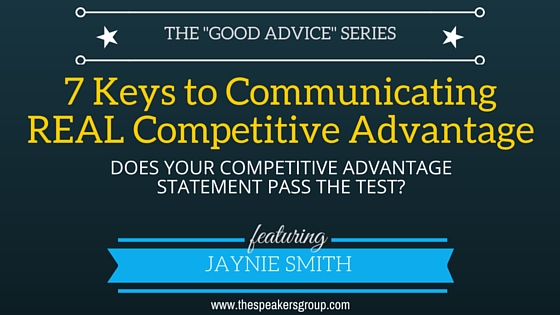
“Why should I do business with you, instead of your competition?”
It’s a question that virtually every one of your customers–or prospective customers–is asking, whether spoken or not. In other words, what is your #1 competitive advantage?
This is a critical question, and one that nearly four thousand CEOs couldn’t answer clearly about their companies, according to competitive advantage expert Jaynie Smith. (She discussed the problem–and ways to solve it–on a recent episode of The Better Life/Better Business Podcast.)
How big is this problem? Consider: If a CEO cannot name the #1 competitive advantage of his or her company, or can’t state clearly why customers should choose to do business with them instead of with their competitors, how can the company’s sales and marketing personnel communicate this information to customers or in advertising campaigns? In other words, the problem is huge.
Smith estimates that between 90 and 95 percent of businesses “leave money on the table every single day” because they cannot state precisely what their own competitive advantages are. These businesses have competitive advantages. They just have not been identified and put into words in such a manner that customers will take notice.
So… How is your company’s competitive advantage statement?
Smith has identified seven qualifications of an effective competitive advantage statement, and you can put yours to the test by running it through this filter right now:
- Is it objective? Obviously you think your company’s products or services are great, but your customers don’t want your opinion. They’re looking for undeniable truth.
- Is it quantifiable? For example, if you’re in a service business and customer service is your competitive advantage, maybe that’s quantified as, “last year we answered 97 percent of all calls within an hour, and the other three percent within 24 hours.”
- Has it been stated by the competition? Then it’s not a competitive advantage. You must have something that is “different from or better than what the competition has to offer.”
- Is it a cliché? We’ve all heard enough marketing clichés, haven’t we? You can do better than that.
- Is it true? In other words, “we can prove it.” (See question #1 above.)
- Is it relevant? “A company strength or customer benefit does not become a competitive advantage unless it is something the consumer wants and appreciates.”
- Is it stated in the past tense? “If it is on time delivery, when I talk about being measurable, don’t tell me ‘we will deliver within 24 hours.’ That’s a promise. Nobody believes promises. Say, ‘we have been measuring on-time delivery for the past three years, and we’re tracking at an average of 98.6 percent.'”
Companies that put forth the effort to ensure that they correctly determine their most important competitive advantages, those that truly matter to both current and prospective customers, will find themselves growing by leaps and bounds. On the other hand, CEOs who believe their businesses are bulletproof because they currently are doing well may suddenly find themselves struggling to survive.
Spend a little time testing and–if necessary–refining your competitive advantage statement today and join the five to 10 percent of companies that aren’t leaving money on the table due to poorly communicated competitive advantage.
For more help with identifying and communicating your competitive advantage, hire The Speakers Group’s competitive advantage expert Jaynie Smith to speak at an upcoming meeting or conference.